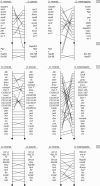Rates and patterns of chromosomal evolution in Drosophila pseudoobscura and D. miranda
- PMID: 16547107
- PMCID: PMC1526542
- DOI: 10.1534/genetics.105.054585
Rates and patterns of chromosomal evolution in Drosophila pseudoobscura and D. miranda
Abstract
Comparisons of gene orders between species permit estimation of the rate of chromosomal evolution since their divergence from a common ancestor. We have compared gene orders on three chromosomes of Drosophila pseudoobscura with its close relative, D. miranda, and the distant outgroup species, D. melanogaster, by using the public genome sequences of D. pseudoobscura and D. melanogaster and approximately 50 in situ hybridizations of gene probes in D. miranda. We find no evidence for extensive transfer of genes among chromosomes in D. miranda. The rates of chromosomal rearrangements between D. miranda and D. pseudoobscura are far higher than those found before in Drosophila and approach those for nematodes, the fastest rates among higher eukaryotes. In addition, we find that the D. pseudoobscura chromosome with the highest level of inversion polymorphism (Muller's element C) does not show an unusually fast rate of evolution with respect to chromosome structure, suggesting that this classic case of inversion polymorphism reflects selection rather than mutational processes. On the basis of our results, we propose possible ancestral arrangements for the D. pseudoobscura C chromosome, which are different from those in the current literature. We also describe a new method for correcting for rearrangements that are not detected with a limited set of markers.
Figures




References
-
- Ashburner, M., 1989. Drosophila: A Laboratory Handbook. Cold Spring Harbor Laboratory Press, Cold Spring Harbor, NY.
-
- Aulard, S., J. R. David and F. Lemeunier, 2002. Chromosomal inversion polymorphism in Afrotropical populations of Drosophila melanogaster. Genet. Res. 79: 49–63. - PubMed
-
- Aulard, S., P. Vaudin, V. Ladeveze, N. Chaminade, G. Periquet et al., 2004. Maintenance of a large pericentric inversion generated by the hobo transposable element in a transgenic line of Drosophila melanogaster. Heredity 92: 151–155. - PubMed
-
- Bachtrog, D., 2003. Adaptation shapes patterns of genome evolution on sexual and asexual chromosomes in Drosophila. Nat. Genet. 34: 215–219. - PubMed
Publication types
MeSH terms
Substances
LinkOut - more resources
Full Text Sources
Molecular Biology Databases

